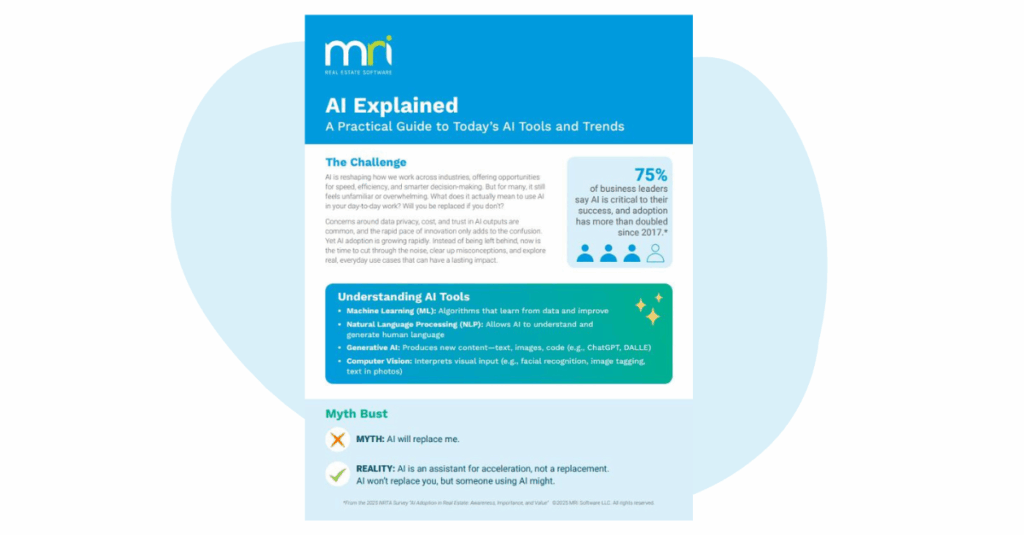Multifamily fraud prevention strategies to protect your portfolio
The multifamily housing sector is transforming rapidly under digitalization. Online applications, automated screening, and digital payments have made leasing more efficient, but they’ve also opened new vulnerabilities. Fraudsters now exploit fake documents, synthetic identities, and payment scams to target portfolios, leaving property operators exposed to financial and reputational damage.
For multifamily leaders, fraud prevention is about more than just protecting the bottom line. It’s about ensuring safe, secure communities for residents, preserving credibility with investors, and maintaining operational stability in a shifting market. This guide examines why fraud prevention is critical, outlines common fraud schemes, presents proven countermeasures, and demonstrates how MRI Software’s multifamily solutions help safeguard your properties.
Why Fraud Prevention Is Critical in Multifamily Real Estate
Before diving into tactics, it’s important to understand why fraud prevention must be a priority today. As fraud escalates in multifamily markets worldwide, operators who treat screening as a checkbox risk being hit by costly exposures. Recent industry analyses show real estate as a top target for fraud, with applications involving falsified background checks, manipulated documents, and identity theft becoming more common.
Fraud affects not only revenue but trust. A single fraudulent lease can trigger a cascade of costs, from eviction and legal fees to lost rent, and can shake confidence among existing residents. The reputational damage from security lapses or financial losses can impact leasing velocity, investor sentiment, and long-term portfolio value. Because the digital leasing landscape removes many of the old safeguards, operators must adopt robust, proactive measures to stay ahead.
Common Types of Fraud in Multifamily Housing
Before defending your property, you must know what you’re defending against. Here’s a deeper look at the most prevalent fraud schemes in multifamily housing:
Identity Fraud in Lease Applications
Fraudsters often use stolen social security numbers, synthetic identifiers (combinations of real and fictitious data), or entirely fabricated personas to slip through applicant screening. Initially, these identities may pass credit and background checks. But once the tenant moves in, defaults or criminal behavior may surface. Recovery is often difficult, and the damage to community trust is significant.
Payment Fraud and Chargebacks
Digital rent payments bring convenience, but can also create new areas of risk. Fraudsters may submit payments using stolen credit cards or compromised bank accounts. After moving in, they may initiate chargebacks, effectively reversing payments and leaving property operators with a loss. Because the unit is already occupied, recouping those funds is typically a lengthy and expensive process.
Fraudulent Documentation
In many cases, fraudulent applicants submit fake pay stubs, altered bank statements, or forged employment letters. With AI-based tools now capable of generating realistic documents, manual checks frequently fall short. Accepting these documents raises default risks and can expose operators during audits or compliance reviews.
Subleasing and Unauthorized Occupants
Some residents engage in subleasing or introduce extra occupants not listed on the lease. These arrangements often violate lease terms, create liability exposure, cause increased wear-and-tear, and complicate safety compliance. They also erode the intended control of occupancy rules the operator set.
Vendor or Procurement Fraud
Fraud doesn’t always come from tenants. Weak internal processes or a lack of oversight can lead to inflated vendor invoices, payments to fictitious “ghost” vendors, or kickbacks. In many cases, procurement fraud erodes margins gradually and can go undetected without strong audit control systems.
Proven Multifamily Fraud Prevention Strategies
Combatting fraud requires multiple layers of defense. The strategies below, when applied consistently and in combination, significantly reduce risk.
Rigorous Tenant Screening and Background Checks
Begin with a strong foundation. Thorough screening, covering credit, criminal, and eviction history, provides early warning on high-risk candidates. But consistency is essential. When your screening thresholds, document criteria, and decision rules are uniform across all properties, you reduce the risk of human bias, loopholes, or oversight.
Digital Identity Verification Tools
Traditional ID checks are no longer sufficient. Modern platforms integrate identity verification that scans government-issued documents, cross-checks them against external databases, and employs biometric checks (e.g. facial matching). These tools flag inconsistencies or fraud attempts at the earliest point, reducing reliance on human inspection.
Automated Income and Employment Verification
Fraudsters often create fake pay stubs or employment letters to appear financially eligible. Automated verification repairs this vulnerability by connecting to payroll systems and financial institutions, verifying income in real time. This not only weeds out falsified documents, but also accelerates approval for legitimate applicants.
Secure Payment Portals with Fraud Detection
A secure, PCI-compliant payment portal is essential. But more than security, it must include fraud detection logic. Algorithms can flag mismatched accounts, multiple payment retries, or unusual patterns for manual review. This layer helps reduce chargebacks and shields operations from needless risk.
Lease Audit Trails and Digital Signatures
Digital leasing platforms generate immutable audit trails. You can see who signed what, when, from which device, and whether any changes were made. Combined with digital signatures, this layer prevents tampering, adds legal enforceability, and provides strong protection in the event of disputes.
Staff Training and Fraud Awareness Programmes
Even the best systems rely on vigilant staff. Regular training sessions help leasing teams identify red flags, such as rushed applicants, suspicious documentation, or reluctance to provide standard verification. Empowered staff know when to pause, question, and escalate. Over time, cultivating a culture of vigilance becomes one of your strongest anti-fraud barriers.
How Technology Enhances Fraud Prevention
Fraud in multifamily housing is evolving quickly, but so are the tools to combat it. By implementing proven prevention strategies and leveraging advanced technologies, property managers can protect revenue, strengthen resident trust, and maintain investor confidence.
When you stack intelligent tools with your team, fraud detection becomes proactive rather than reactive:
Real-Time Document Authentication
AI-based document authentication evaluates uploaded files instantly, checking for manipulated metadata, mismatched fonts, or known forgery signatures. This automation filters out suspect applications before they progress, reducing manual review load and improving accuracy.
AI-Driven Pattern Recognition and Alerts
Machine learning models can detect subtle patterns across applications and payments that humans might miss, for example repeated use of the same postcode, IP address reuse, or account overlaps. When anomalies arise, alerts can trigger further investigation, stopping fraud before action is taken.
Integration with Credit Bureaus and Identity Providers
When leasing systems integrate directly with credit bureaus and trusted identity sources, much of verification becomes seamless. Operators get validated applicant data in real time, which both speeds approvals and raises confidence in decision-making.
Centralised Audit Logs and Reporting
Transparent investigations require traceability. Centralised logs capture every action, including document uploads, edits, approvals, and signatures, across all properties. This unified system supports internal audits, compliance reviews, and legal defense if needed.
Using MRI Software to Minimize Fraud Risk
With MRI Software’s multifamily solutions, fraud prevention becomes part of everyday leasing and payment workflows. By combining secure screening, digital verification, fraud detection, and audit trails, MRI enables property professionals to stay ahead of evolving threats and ensure their portfolios remain profitable, compliant, and resilient.
- MRI Screening: offers background checks, identity validation, and automatic income verification, all from a single interface.
- MRI Payments: supports secure, PCI-compliant transactions with built-in fraud monitoring to catch suspicious activity in real time.
- MRI Document Management: stores and tracks documents securely, preserving audit trails and enforcing version control.
- Your operations benefit from a seamless integration across the screening, leasing, and payment workflows, ensuring fraud checks happen automatically at the proper stage without manual transfers or bottlenecks.
How MRI Screening Integrates with Leasing Workflows
Fraud prevention must align with everyday leasing operations. MRI Screening inserts verification steps directly into application workflows, so identity, income, and background checks occur before a lease is approved.
Meanwhile, MRI Payments ensures rent collection continues under careful surveillance, and MRI Document Management locks down document integrity. This integration creates a closed-loop prevention system, ensuring that risk detection is part of standard processing, not an afterthought.
Property Management Software
Multi-discipline technology for property owners, investors and occupiers.

FAQs
AI Explained: A Practical Guide to Today’s AI Tools and Trends
AI is reshaping how we work across industries, offering opportunities for speed, efficiency, and smarter decision-making. But for many, it still feels unfamiliar or overwhelming. What does it actually mean to use AI in your day-to-day work? Will you …
